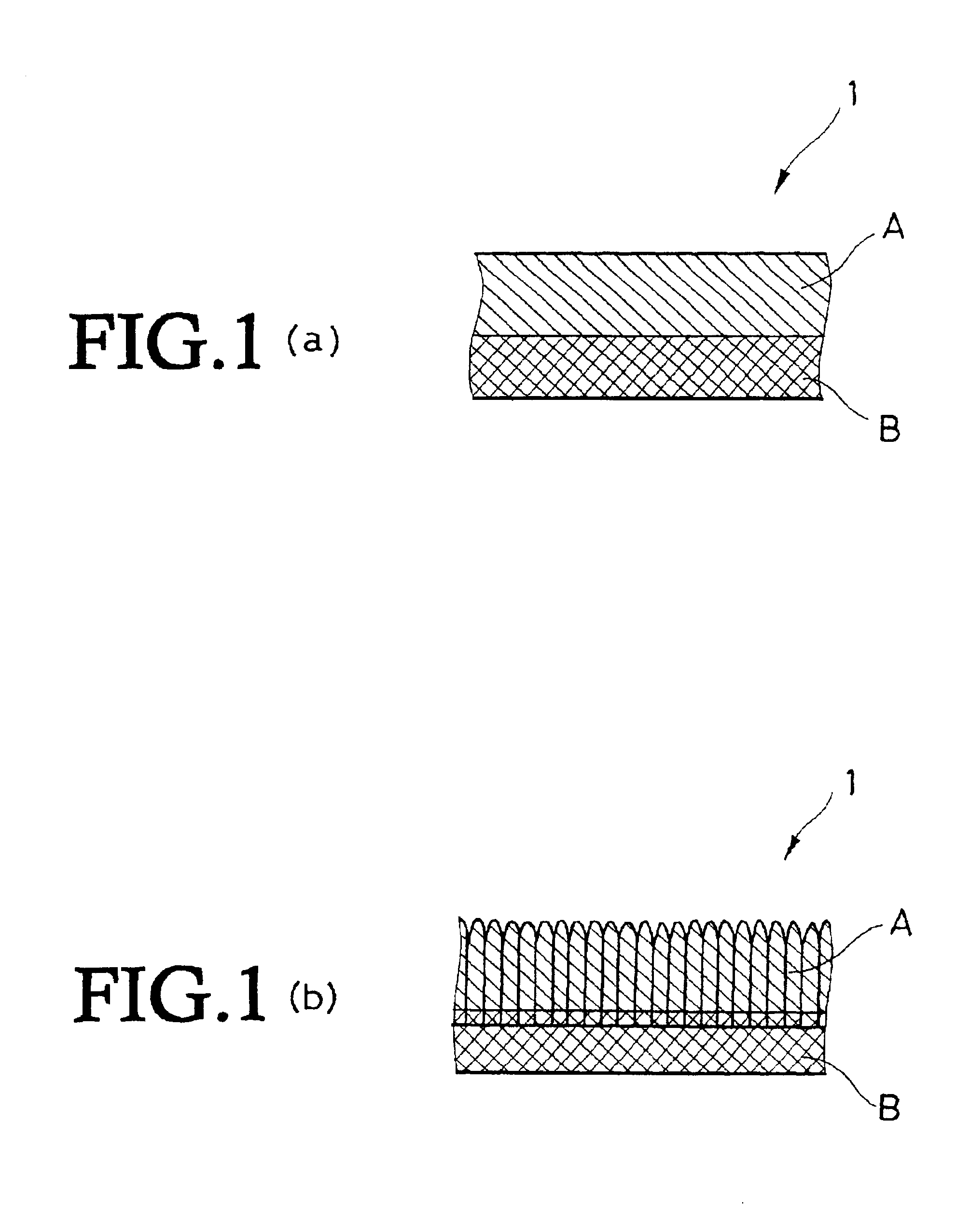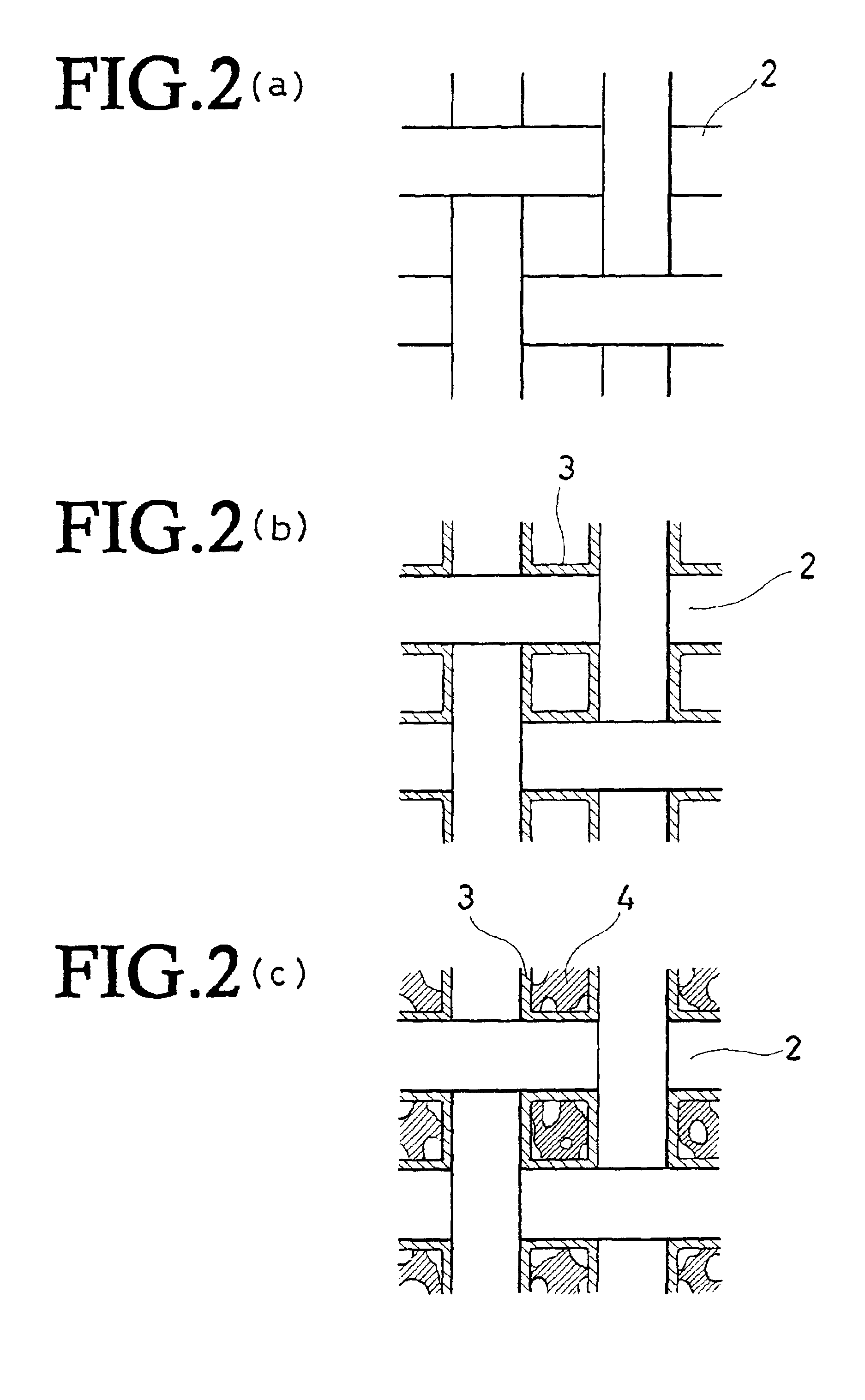Fabric for use in ink-jet printing, a method for preparing such fabric and printed goods made by ink-jet printing of the fabric
a technology of fabric and inkjet printing, which is applied in the directions of weaving, dyeing process, transportation and packaging, etc., can solve the problems of ink bleeding from design patterns printed on the fabric, failure to prevent, and ink applied to the fabric failing to penetrate fully into the inside of the fabri
- Summary
- Abstract
- Description
- Claims
- Application Information
AI Technical Summary
Benefits of technology
Problems solved by technology
Method used
Image
Examples
example 1
[0130]A solution containing an ink holding agent of high wettability to synthetic fiber (hereinafter referred to as “Solution A1”) was prepared according to the following recipe:
[0131]
PVA205 (Kuraray-made3 partssynthetic polymer based on polyvinyl alcohol)REACTANT MS (Uni Kasei-made antireductant)1 partMalic acid (diluted with water to 50%)0.5 partUNIGUARD E-200N (Dai-ichi Kogyo Seiyaku-1 partmade light fastness improver)WaterRestTotal100 partsViscosity: 80 cps
[0132]Napped polyester 100% double raschel knitted fabric conventionally desized and scoured was treated with Solution A1 by a mangle-pad method. The fabric was then subjected to hot-air drying at 180° C. for 3 minutes.
[0133]A solution containing an ink holding agent of low wettability to synthetic fiber (hereinafter referred to as “Solution B1”) was prepared according to the following recipe:
[0134]
FINE GUM SP-1 (Dai-ichi Kogyo Seiyaku-made semi-3 partssynthetic polymer based on carboxymethylcellulose)REACTANT MS (Uni Kasei-ma...
example 2
[0142]A solution containing an ink holding agent of high wettability to synthetic fiber (hereinafter referred to as “Solution A2”) was prepared according to the following recipe:
[0143]
Marpozol M-1 (Matsumoto Yushi-made synthetic polymer3 partsbased on polyacrylate)REACTANT MS (Uni Kasei-made antireductant)1 partMalic acid (diluted with water to 50%)0.5 partUNIGUARD E-200N (Dai-ichi Kogyo Seiyaku-made light1 partfastness improver)WaterRestTotal100 partsViscosity: 50 cps
[0144]This example was pursuant to Example 1 except for the use of napped polyester 80% / cotton 20% knitted fabric instead of napped polyester 100% knitted fabric and Solution A2 instead of Solution A1.
example 3
[0145]A solution containing an ink holding agent of low wettability to synthetic fiber (hereinafter referred to as “Solution B2”) was prepared according to the following recipe:
[0146]
KIPROGUM F500 (Nippon Starch Chemical-made natural5 partspolymer based on starch)REACTANT MS (Uni Kasei-made antireductant)1 partMalic acid (diluted with water to 50%)0.5 partUNIGUARD E-200N (Dai-ichi Kogyo Seiyaku-made1 partlight fastness improver)WaterRestTotal100 parts
[0147]This example was pursuant to Example 1 except for the use of Solution B2 instead of Solution B1.
PUM
| Property | Measurement | Unit |
|---|---|---|
| wettability | aaaaa | aaaaa |
| flexible | aaaaa | aaaaa |
| affinity | aaaaa | aaaaa |
Abstract
Description
Claims
Application Information
 Login to View More
Login to View More - R&D
- Intellectual Property
- Life Sciences
- Materials
- Tech Scout
- Unparalleled Data Quality
- Higher Quality Content
- 60% Fewer Hallucinations
Browse by: Latest US Patents, China's latest patents, Technical Efficacy Thesaurus, Application Domain, Technology Topic, Popular Technical Reports.
© 2025 PatSnap. All rights reserved.Legal|Privacy policy|Modern Slavery Act Transparency Statement|Sitemap|About US| Contact US: help@patsnap.com



